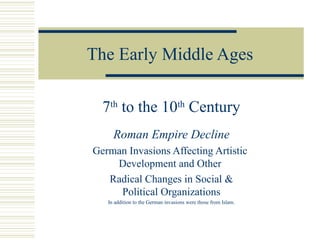
Early christian and byzantine art (1)
- 1. The Early Middle Ages 7th to the 10th Century Roman Empire Decline German Invasions Affecting Artistic Development and Other Radical Changes in Social & Political Organizations In addition to the German invasions were those from Islam.
- 2. Islamic Art Idolatry forbidden Consisted mainly of abstracts, floral patterns, or other geometric objects Sculpture almost nonexistent Abundance of monumental architecture & architectural decorations
- 3. Islamic Art Expressions Mosque: A place to pray and face towards Mecca Sahn: enclosed courtyard that all mosques have. Qibla: prayer wall Mihrab: small nitche to indicate the direction of Mecca. Exterior: Tall minarets Large and elaborate Hagia Sophia changed into a mosque
- 4. Islam Islam means “submission to God’s will” Founded by the prophet Muhammed Message is “brotherhood of Man” & equality before God (Allah) Differs from Christianity No priesthood, no religious hierarchy, sacraments or requirements of literagy Does include rulers and leaders in prayer
- 5. Islamic Instruction Faithfully conduct their daily lives Circumcise male infants Pray to Allah five times a day facing Mecca. Worship in the mosque on Fridays Give to the poor, Fast and practice abstinence in the daylight during Ramaden Allowed multiple wives
- 6. The Great Mosque, Cordoba Mosque built in capital city Striking example of Islamic art Double arches first used here were duplicated in additions. (11.1,11.2, 11.3 & 11.4) Christians later turned this into a cathedral but it still conveys the original orientation of Islam.
- 7. Northern European Art Influenced by the Germanic tribes New focus on artistic and political activities No monumental structure, paintings or sculpture was done to the constant invasions Invaders stimulated a new craft. . . Metalwork designs and techniques
- 8. Anglo-Saxon Metalwork Purse cover from the 17th century. Found among a pagan ship wreckage treasures suggesting royalty Is of gold decoration; cloisonne enamel originally on ivory or bone & dark red garnets. Early Christian intelace designs and Near Eastern motifs SuttonHoo purse cover from East Anglia, England, 630 AD Merging animal forms suggest invasion
- 9. Beowulf Earliest surviving European epic German folklore with strong Christian morality. A strange king child found adrift Denmark “Scyld Scefing” Famed was this Beowulf: far flew the boast of him, son of Scyld, in the Scandian lands. So becomes it a youth to quit him well with his father's friends, by fee and gift, that to aid him, aged, in after days, come warriors willing, should war draw nigh, liegemen loyal: by lauded deeds shall an earl have honor in every clan.
- 10. Hiberno-Saxon Art Ireland escaped invasions at this time St. Patrick spread Christianity throughout Ireland and for years later it became a haven for scholars, missionaries, monasteries, . . Christian art also prevailed across Ireland. Style has been called Insular and Hiberno-Saxon (Hiberno is Latin for “Ireland”)
- 11. Manuscript Illumination Illuminated manuscripts produced by monks in monasteries. Illustrated the Word of God; Visual pleasures Used a strict unity of color and form. Crisp, clear sometines contrasting colors; flat surfaces; patterning Lion Symbol of St. John, from the Book of Durrow, After AD650. Represents St. John, Evangelist as a lion . . . .later an eagle.
- 12. Carolingian Period Book of Kells Corresponds with the crowning of Charles the Great-Roman empr. Charlemagne ruled over the Holy Roman Empire and surrounding territories and revived culture. Network of learning was created Latin manuscript texts. . .7LibArts 11.7 Tunc Crucifixerant XPI, from the Book of Kells (Matthew 27:38) Then they crucified Christ & with him two thieves
- 13. Manuscripts Charlemagne’s rule involved the Roman revival of culture with manuscripts Manuscripts worked towards development of a practical form of portable artistic and educational communication They continued after Charlemagne’s death but more apocalyptic approach Flatter space, figures connected by geometric design rather than landscapes.
- 14. Revelation & the Four Symbols of Evangelsits Revelation-last book of the New Testament Written by St. John John’s account of Christ’s word in his appearance to him. Visionary work with scripture, literary tradition and symbols: lion, bull, man, eagle. Lion: St. Mark; Bull: St. Luke; Man: St. Matthew, Eagle: St. John. 11.8 Four Evangelists, from a Carolingian Gospel Book
- 15. Monasteries Each monastery: School Network for artists and scholars to communicate. Religious and Administrative Center for economic functions Communal living quarters for Monks Plans for monstery of St.Gall, Switzerland; plan placed church in the center; building around in order of importance of education
- 16. Ottonian Period Charlemagne’s grandsons were ineffective rulers of the European reign & fell to invaders. After the Vikings takeover, the Saxons crowned Otto I as Otto the Great, emperor. Ottonian refers to rulers named Otto who worked to continue Charlemagne’s revival of Classical antiquity.
- 17. Major Works of the Ottonian Period Architectural work: Benedictine abbey church of St. Michael’s Metalwork at Hildesheim